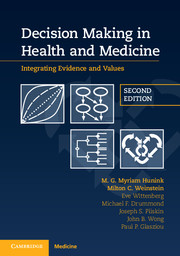Book contents
- Frontmatter
- Dedication
- Contents
- Foreword
- Foreword to the first edition (2001)
- Preface
- Acknowledgments
- list of Abbreviations
- About the authors
- 1 Elements of decision making in health care
- 2 Managing uncertainty
- 3 Choosing the best treatment
- 4 Valuing outcomes
- 5 Interpreting diagnostic information
- 6 Deciding when to test
- 7 Multiple test results
- 8 Finding and summarizing the evidence
- 9 Constrained resources
- 10 Recurring events
- 11 Estimation, calibration, and validation
- 12 Heterogeneity and uncertainty
- 13 Psychology of judgment and choice
- Index
- References
2 - Managing uncertainty
Published online by Cambridge University Press: 05 October 2014
- Frontmatter
- Dedication
- Contents
- Foreword
- Foreword to the first edition (2001)
- Preface
- Acknowledgments
- list of Abbreviations
- About the authors
- 1 Elements of decision making in health care
- 2 Managing uncertainty
- 3 Choosing the best treatment
- 4 Valuing outcomes
- 5 Interpreting diagnostic information
- 6 Deciding when to test
- 7 Multiple test results
- 8 Finding and summarizing the evidence
- 9 Constrained resources
- 10 Recurring events
- 11 Estimation, calibration, and validation
- 12 Heterogeneity and uncertainty
- 13 Psychology of judgment and choice
- Index
- References
Summary
Much of medical training consists of learning to cope with pervasive uncertainty and with the limits of medical knowledge. Making serious clinical decisions on the basis of conflicting, incomplete, and untimely data is routine.
J.D. McCueIntroduction
Much of clinical medicine and health care involves uncertainties: some reducible, but some irreducible despite our best efforts and tests. Better decisions will be made if we are open and honest about these uncertainties, and develop skills in estimating, communicating, and working with such uncertainties. What types of uncertainty exist? Consider the following example.
Needlestick injury:
It has been a hard week. It is time to go home when you are called to yet another heroin overdose: a young woman has been found unconscious outside your clinic. After giving intravenous (IV) naloxone (which reverses the effects of heroin), you are accidentally jabbed by the needle. After her recovery, despite your reassurances, the young woman flees for fear of the police. As the mêlée settles, the dread of human immunodeficiency virus (HIV) infection begins to develop. You talk to the senior doctor about what you should do. She is very sympathetic, and begins to tell you about the risks and management. The good news is that, even if the patient was HIV-positive, a needlestick injury rarely leads to HIV infection (about 3 per 1000). And if she was HIV-positive then a basic two-drug regime of antivirals such as zidovudine (AZT) plus lamivudine are likely to be able to prevent most infections (perhaps 80%).
Unfortunately, the HIV status of the young woman who had overdosed is unknown. Since she was not a patient of your clinic, you are uncertain about whether she is infected, but think that it is possible since she is an IV drug user. The Centers for Disease Control and Prevention (CDC) guidelines (1) suggest: ‘If the exposure source is unknown, use of post-exposure prophylaxis should be decided on a case-by-case basis. Consider the severity of exposure and the epidemiologic likelihood of HIV.’ What do you do?
- Type
- Chapter
- Information
- Decision Making in Health and MedicineIntegrating Evidence and Values, pp. 29 - 52Publisher: Cambridge University PressPrint publication year: 2014



